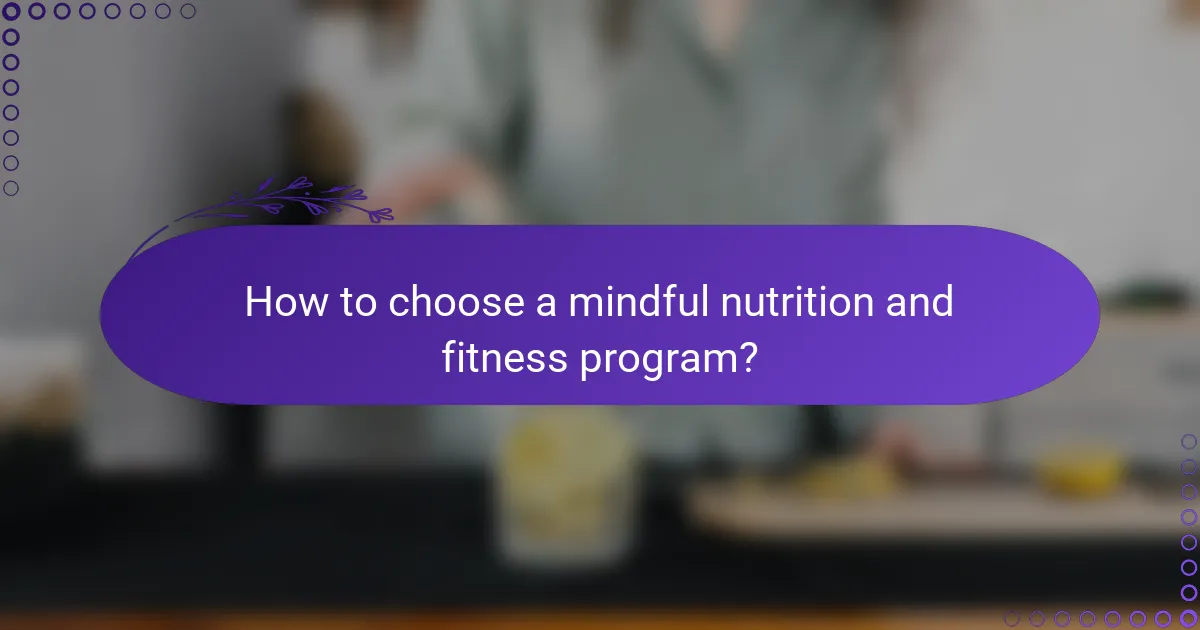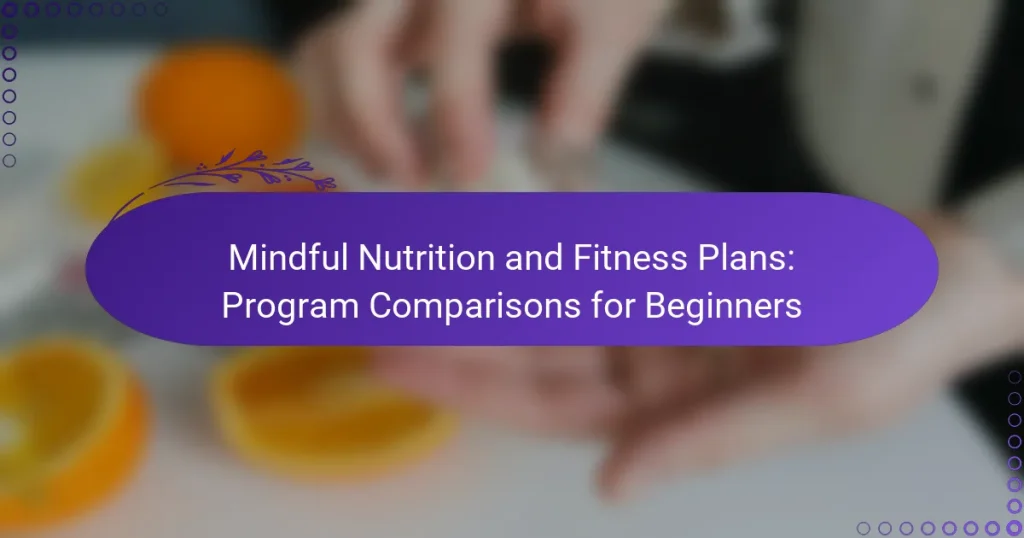Mindful nutrition and fitness plans are essential for beginners looking to cultivate a healthier lifestyle. By focusing on whole foods and balanced meals, these plans encourage a deeper awareness of food choices while integrating physical activity to enhance overall well-being. Understanding the various program options available can help individuals select the best approach that aligns with their personal goals and preferences.

What are the best mindful nutrition plans for beginners?
The best mindful nutrition plans for beginners focus on whole foods, balanced meals, and sustainable habits. These plans encourage awareness of food choices and promote a healthier relationship with eating.
Whole30 program
The Whole30 program is a 30-day dietary reset that eliminates sugar, grains, dairy, and legumes. It emphasizes whole, unprocessed foods, encouraging participants to focus on vegetables, fruits, and high-quality proteins.
While Whole30 can help identify food sensitivities, it may feel restrictive for some. Beginners should prepare for a commitment to meal planning and cooking, as convenience foods are not allowed.
Common pitfalls include not having enough meal options and feeling deprived. To succeed, stock up on compliant foods and plan meals ahead of time.
Plant-based diet
A plant-based diet centers on whole, minimally processed plant foods, including fruits, vegetables, grains, nuts, and seeds. This approach promotes health and environmental sustainability by reducing animal product consumption.
Beginners should focus on incorporating a variety of foods to ensure adequate nutrient intake, particularly protein, iron, and vitamin B12. Simple swaps, like using lentils instead of meat, can make the transition easier.
To avoid deficiencies, consider consulting a nutritionist for tailored advice. Meal prep can help maintain variety and prevent boredom with meals.
Paleo diet
The Paleo diet emphasizes foods presumed to be available to our ancestors, such as lean meats, fish, fruits, vegetables, nuts, and seeds, while excluding processed foods, grains, and dairy. This diet aims to promote health by aligning with our evolutionary biology.
Beginners should focus on whole foods and avoid processed snacks. Meal planning is essential to ensure a balanced intake of nutrients and to prevent reliance on convenience foods.
Be cautious of high costs associated with purchasing organic meats and produce. Budgeting and meal prepping can help manage expenses while following this diet.
Mediterranean diet
The Mediterranean diet is based on traditional eating patterns from countries bordering the Mediterranean Sea. It emphasizes fruits, vegetables, whole grains, legumes, nuts, olive oil, and moderate amounts of fish and poultry.
This diet is known for its heart health benefits and encourages a balanced approach to eating. Beginners should focus on incorporating more plant-based foods while reducing red meat and processed foods.
To make the diet more accessible, consider starting with simple recipes and gradually increasing the variety of foods. Engaging in mindful eating practices, such as savoring meals, can enhance the experience.

How do fitness plans complement mindful nutrition?
Fitness plans enhance mindful nutrition by promoting a balanced approach to health that integrates physical activity with dietary choices. Together, they support overall well-being, allowing individuals to achieve their health goals more effectively.
Increased energy levels
Engaging in regular physical activity boosts energy levels by improving cardiovascular health and increasing stamina. When combined with mindful nutrition, which focuses on nutrient-dense foods, individuals often experience sustained energy throughout the day.
For instance, incorporating complex carbohydrates like whole grains and pairing them with protein sources can provide a steady energy release. Aim for meals that include these elements, especially before workouts, to maximize energy availability.
Improved mental clarity
Fitness plans that include aerobic exercises can enhance mental clarity by increasing blood flow to the brain. This improved circulation, along with a diet rich in omega-3 fatty acids and antioxidants, supports cognitive function and reduces mental fatigue.
Consider activities like brisk walking or cycling, which can be complemented by foods such as fatty fish, nuts, and berries. These combinations can lead to sharper focus and better decision-making throughout the day.
Enhanced weight management
Combining fitness plans with mindful nutrition is effective for weight management. Regular exercise helps burn calories, while mindful eating encourages awareness of portion sizes and food choices, making it easier to maintain a healthy weight.
To manage weight effectively, aim for at least 150 minutes of moderate aerobic activity weekly, alongside a balanced diet that emphasizes whole foods. Avoiding processed foods and sugary beverages can significantly aid in achieving weight goals.

What are the key features of popular fitness programs?
Popular fitness programs often focus on specific goals, such as improving mindfulness, enhancing efficiency, or building muscle. Each program has unique characteristics that cater to different preferences and lifestyles, making it essential for beginners to understand their options.
Yoga for mindfulness
Yoga emphasizes mindfulness through breath control, meditation, and physical postures. This practice encourages participants to connect their mind and body, promoting relaxation and stress reduction.
For beginners, starting with basic poses like Downward Dog or Child’s Pose can help build a foundation. Classes often vary in intensity, so it’s beneficial to choose a style that matches your comfort level, such as Hatha for a gentle approach or Vinyasa for a more dynamic flow.
To maximize benefits, aim for at least two sessions per week, focusing on your breathing and being present in the moment. Avoid pushing yourself into advanced poses too quickly, as this can lead to injury.
HIIT for efficiency
High-Intensity Interval Training (HIIT) is designed for those seeking efficient workouts that maximize calorie burn in a short time. This approach alternates between intense bursts of activity and brief recovery periods, making it ideal for busy schedules.
Beginners can start with sessions lasting 15-30 minutes, incorporating exercises like jumping jacks, burpees, or sprints. A common structure is 20 seconds of work followed by 10 seconds of rest, repeated for several rounds.
To ensure safety, focus on proper form and gradually increase intensity. It’s crucial to listen to your body and allow adequate recovery time between sessions to prevent overtraining.
Strength training for muscle
Strength training focuses on building muscle mass and improving overall strength through resistance exercises. This can be achieved using free weights, machines, or bodyweight exercises, making it accessible for beginners.
Start with fundamental movements such as squats, push-ups, and lunges, aiming for two to three sessions per week. A typical beginner routine may include 8-12 repetitions of each exercise, with a focus on proper technique over heavy weights.
To avoid common pitfalls, ensure a balanced approach by incorporating rest days and varying your workouts. Tracking your progress can help maintain motivation and guide adjustments to your routine as you advance.

How to choose a mindful nutrition and fitness program?
Choosing a mindful nutrition and fitness program involves evaluating your personal goals, dietary preferences, and time commitment. A thoughtful approach ensures that the program aligns with your lifestyle and promotes lasting health benefits.
Assess personal goals
Begin by identifying what you want to achieve with your nutrition and fitness plan. Common goals include weight loss, muscle gain, improved energy levels, or enhanced overall well-being. Clearly defined objectives will guide your program selection and help you stay motivated.
Consider using the SMART criteria—Specific, Measurable, Achievable, Relevant, and Time-bound—to refine your goals. For example, instead of saying “I want to lose weight,” specify “I aim to lose 5 kg in three months by exercising three times a week and following a balanced diet.”
Consider dietary preferences
Your dietary preferences play a crucial role in choosing a nutrition program. Whether you prefer vegetarian, vegan, gluten-free, or omnivorous diets, ensure the program accommodates your choices. This alignment will make it easier to stick to the plan and enjoy your meals.
Research various dietary approaches, such as Mediterranean, paleo, or intermittent fasting, to find one that resonates with your lifestyle. For instance, if you enjoy cooking, a program that emphasizes whole foods and meal prep might suit you better than one focused on convenience foods.
Evaluate time commitment
Assess how much time you can realistically dedicate to your nutrition and fitness program. Consider both meal preparation and workout sessions. A program that requires extensive meal prep may not be suitable if you have a busy schedule.
As a guideline, aim for at least 150 minutes of moderate aerobic activity per week, along with strength training on two or more days. If time is limited, look for high-intensity workouts that can be completed in shorter durations, such as 20-30 minutes, while still being effective.

What are the costs associated with nutrition and fitness plans?
The costs associated with nutrition and fitness plans can vary widely based on individual choices and local markets. Key expenses typically include monthly subscription fees for programs, grocery expenses for healthy foods, and gym membership costs for access to facilities and equipment.
Monthly subscription fees
Monthly subscription fees for nutrition and fitness plans can range from low to moderate amounts, often between $10 to $50 per month. These fees may cover access to workout programs, meal plans, or coaching services. When selecting a subscription, consider what features are included and whether they align with your personal goals.
Some platforms offer free trials or tiered pricing, allowing you to start with minimal investment. Be cautious of auto-renewal policies that may lead to unexpected charges if you forget to cancel.
Grocery expenses
Grocery expenses for healthy eating can vary significantly based on dietary preferences and local prices. On average, individuals might spend between $50 to $150 per week on groceries, depending on whether they prioritize organic foods or specialty items. Planning meals and shopping with a list can help manage these costs effectively.
Consider buying in bulk or choosing seasonal produce to save money. Avoiding pre-packaged meals can also reduce expenses while promoting healthier eating habits.
Gym membership costs
Gym membership costs typically range from $20 to $100 per month, depending on the facility’s amenities and location. Basic gyms may offer lower rates, while those with extensive services like pools or classes can charge more. Look for promotions or discounts, especially at the beginning of the year or during summer months.
Some gyms offer pay-per-visit options, which can be more economical if you plan to work out infrequently. Always read the fine print regarding cancellation policies and additional fees, such as initiation or maintenance charges.

What are the benefits of combining nutrition and fitness?
Combining nutrition and fitness offers numerous benefits, including improved physical health, enhanced mental well-being, and better overall quality of life. This integrated approach helps individuals achieve their health goals more effectively by addressing both dietary habits and physical activity simultaneously.
Holistic health improvement
Combining nutrition and fitness leads to holistic health improvement by addressing multiple aspects of well-being. A balanced diet provides the necessary nutrients for energy, while regular exercise enhances cardiovascular health, muscle strength, and flexibility. Together, they create a synergistic effect that promotes overall vitality.
To maximize these benefits, consider incorporating a variety of foods that support your fitness routine. For example, lean proteins, whole grains, and plenty of fruits and vegetables can fuel workouts and aid recovery. Aim for a balanced plate that includes all food groups to ensure comprehensive nutrition.
Be mindful of common pitfalls, such as relying solely on exercise without proper nutrition or vice versa. A well-rounded approach that includes both elements will yield better results. Regularly assess your progress and adjust your nutrition and fitness plans as needed to stay aligned with your health goals.


